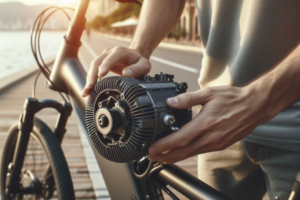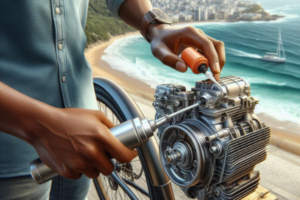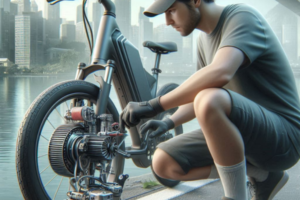🌧️ Why Motor Maintenance Is Essential for E-Bikes in Coastal Cities
Riding an electric bicycle along coastal roads can feel like a dream—fresh ocean air, scenic views, and a sustainable way to commute. However, beneath that coastal charm lies a silent threat: humidity. The combination of moisture, salty air, and temperature fluctuations can significantly reduce the life expectancy of your e-bike motor if proper maintenance isn’t part of your routine. In coastal cities, motor maintenance isn’t optional—it’s essential.
Humidity doesn’t just affect the exterior of your bicycle; it penetrates deep into its components, especially the motor. While many electric bicycle motors come with water-resistant seals or casings, these protections are not foolproof. Salt particles suspended in humid air can cling to your bike’s surfaces and enter through microscopic gaps. Over time, this results in oxidation, corrosion, and eventual performance loss.
The motor of your e-bike is its heart. It regulates speed, handles torque, and translates your energy into motion. When exposed to high-humidity environments without adequate care, the internal circuits, bearings, and wiring can begin to degrade. Signs of early damage may include erratic acceleration, reduced battery efficiency, strange noises, or overheating. These issues can escalate quickly if not addressed, often requiring costly repairs or motor replacements.
A proactive maintenance routine specifically tailored for coastal environments is your best defense. In dry cities, general maintenance might involve occasional cleaning and tire checks. But near the sea, your e-bike needs more: corrosion prevention, storage strategies, and consistent inspections. The goal is to protect not just the visible components, but also the internal motor mechanics that keep your ride smooth and reliable.
🌫️ Understanding the Unique Risks of Coastal Climates
Coastal cities present a unique set of environmental stressors for electric bicycles. The combination of airborne salt, ambient humidity, and frequent weather changes creates a perfect storm for corrosion. Even if you don’t ride during rainy conditions, moisture still accumulates through condensation—especially overnight. This buildup forms a thin layer on your bike’s motor and frame, increasing the risk of rust and short circuits.
One of the lesser-known risks in coastal areas is galvanic corrosion. This occurs when dissimilar metals on your bike—like those found in connectors, fasteners, and internal components—react with electrolytes from salt and moisture. It accelerates metal degradation, especially in motors that are not coated or cleaned regularly. Galvanic corrosion is difficult to reverse once it begins, which makes prevention even more critical.
📊 Quick Comparison: Inland vs. Coastal E-Bike Motor Exposure
| Environment | Humidity Levels | Corrosion Risk | Maintenance Frequency |
|---|---|---|---|
| Inland Urban City | Low to moderate | Minimal | Every 2–3 months |
| Coastal City (high humidity) | High to extreme | Severe | Weekly to bi-weekly |
If you’re living in a coastal environment, understanding the threats posed by your surroundings is the first step. The second is committing to consistent, mindful maintenance that extends the life of your motor and protects your investment. This guide will take you through the most effective practices, expert tips, and avoidable mistakes to keep your electric bicycle running like new—no matter how close you live to the ocean.
💡 Inspiration: “The sea may bring salt and wind—but with the right care, your motor brings freedom.”
🧰 Establishing a Routine Maintenance Plan for Coastal E-Bike Motors
Once you understand the risks that coastal humidity presents to your e-bike motor, the next step is building a reliable, realistic maintenance plan. You don’t need to be a mechanic or spend hours each week servicing your bike, but you do need a smart, consistent routine that fits the challenges of your environment. Preventive care is always more affordable and less stressful than repairs or replacements.
In coastal cities, your maintenance routine should follow a rhythm aligned with your usage. The more frequently you ride, especially near beaches or during humid mornings, the more attention your motor requires. Salt residue may not be visible, but it accumulates subtly and steadily, settling into gaps and on surfaces after every ride. A basic wipe-down is often not enough—you’ll need to adopt a few specific habits.
🧼 Weekly Motor Maintenance Steps for Coastal Riders
Weekly maintenance doesn’t have to be complex, but it does need to be thorough. The goal is to remove salt and moisture, inspect vulnerable areas, and reinforce protection. Here’s a practical guide to follow:
- Clean the motor casing with a damp cloth: Use a microfiber cloth and lightly moisten it with distilled water. Avoid direct spraying or submerging any part of the bike.
- Dry the entire area completely: Humidity tends to linger in joints. Use a dry cloth and allow natural airflow to finish the job.
- Inspect for corrosion: Look for discoloration, powdery white or green buildup around bolts, connectors, or seams in the casing.
- Apply a protective spray: Use a product designed for metal parts or electronics that offers water resistance. Reapply every 1–2 weeks depending on your exposure level.
- Use dielectric grease on connectors: This keeps moisture out of plug-in points and prevents electrical shorts or rusted terminals.
🚲 Post-Ride Care Tips That Make a Big Difference
Post-ride care is often overlooked, but it’s essential when dealing with coastal humidity. After each ride, especially near the sea or after a foggy morning, take just five to ten minutes for the following:
- Wipe down your bike and motor with a dry microfiber cloth.
- Check under the frame and near the battery area for moisture or debris.
- Hang or park your bike in a dry, elevated place with ventilation.
- Never leave your e-bike near oceanfront walls or saltwater puddles for extended periods.
Adding these steps into your routine doesn’t require a major lifestyle change—it just requires intention. Riders who commit to 10 minutes of care per ride often avoid hundreds of dollars in long-term damage and see far better battery efficiency and motor responsiveness.
📋 Sample Weekly Maintenance Schedule
| Day | Action | Purpose |
|---|---|---|
| Monday | Wipe-down after commute | Remove salt and dust residue |
| Wednesday | Inspect motor casing and bolts | Check for early signs of corrosion |
| Friday | Apply anti-corrosion spray | Reinforce humidity protection |
| Sunday | Clean connectors and apply grease | Prevent electrical faults |
This schedule is just a starting point—you can adapt it based on how often you ride and where you store your bicycle. The key takeaway is consistency. Routine is what separates bikes that thrive from bikes that corrode.
💡 Reminder: Ten minutes today can save you from hours of frustration tomorrow. Treat your motor with the care it deserves.
🛡️ Advanced Protection Strategies for Coastal Motor Longevity
Once you’ve established a basic maintenance routine, it’s time to consider the next level: advanced protection strategies. These techniques are especially valuable for riders who live in coastal cities with consistently high humidity, salt-rich air, or frequent temperature fluctuations. Even if your e-bike is well-maintained, implementing a few advanced strategies can significantly extend motor life, improve reliability, and lower long-term maintenance costs.
Think of this as investing in the future performance of your bike. These methods go beyond cleaning and coating—they’re about preventing internal degradation, optimizing airflow, and using technology to your advantage. Whether you’re an everyday commuter or a weekend rider, these protective steps will ensure your motor remains efficient and trouble-free.
🌬️ Use Ventilated Storage Solutions
The place where your e-bike “sleeps” has a dramatic effect on how well your motor ages. Storing your bicycle in a hot, sealed shed or in a non-ventilated garage can create a microclimate filled with trapped moisture. This accelerates corrosion, even if the bike is not in direct contact with the elements. Instead, opt for well-ventilated areas or use breathable bike covers that allow moisture to escape while blocking salt particles and dust.
You can also place your bike near a small dehumidifier or use silica gel packs around the storage zone. These help absorb airborne moisture and reduce condensation during cool nights. Elevating your e-bike slightly from the floor using a stand or rubber mat also protects it from humidity that rises off concrete surfaces.
🔧 Apply Protective Coatings to Internal Components (With Caution)
If you’re comfortable with light technical maintenance, consider applying a conformal coating to your motor’s exposed circuit boards or connectors. This is especially useful for bikes that undergo high exposure or are stored outdoors. Silicone conformal coatings are often used in marine electronics for their hydrophobic and non-conductive properties. However, it’s crucial to apply them sparingly and only to parts not meant to move or release heat.
If in doubt, consult your bike manufacturer or a certified technician. Some motors may void warranty if opened or tampered with, so proceed only if you’re confident or assisted by a professional.
💨 Maintain Clean Airflow Around the Motor
Many e-bike motors rely on passive cooling systems that depend on airflow. When salt, mud, or dust accumulate on the motor casing, it can block airflow or cause heat to build up unnecessarily. Clean the ventilation areas weekly with a soft brush or compressed air. Avoid covering the motor area with accessories or storage bags that restrict air movement.
🧪 Monitor Motor Health with a Diagnostic App or Sensor
Some mid- to high-end e-bikes come with companion apps that let you track the motor’s temperature, voltage, and error codes in real-time. Using this technology gives you a powerful early-warning system. If your bike doesn’t offer this feature, ask your dealer if a third-party sensor or Bluetooth diagnostic tool is compatible.
🧾 Summary Table: Advanced Strategies at a Glance
| Strategy | Purpose | Best For |
|---|---|---|
| Ventilated storage | Reduce ambient humidity | Urban riders with indoor space |
| Internal coatings | Protect sensitive electronics | High-humidity, exposed conditions |
| Airflow maintenance | Prevent overheating | Riders in hot or dusty regions |
| Motor diagnostics | Track health indicators | Tech-savvy riders, commuters |
Advanced protection isn’t just about fixing problems—it’s about preventing them in the first place. These strategies may require a bit more attention and investment, but the reward is a motor that runs smoother, lasts longer, and resists even the toughest coastal elements.
💡 Insight: Protection doesn’t stop at prevention—it evolves with precision. Give your motor the strategy it deserves.
⚠️ Common Mistakes in Coastal Motor Care — and How to Avoid Them
Even the most well-intentioned riders can unknowingly harm their electric bicycle motor through routine errors. In coastal cities, where the motor faces heightened exposure to moisture and salt, small mistakes can have long-term consequences. Whether it’s skipping a cleaning step, using the wrong product, or storing the bike in a risky location, these oversights can undermine all your protective efforts. Understanding what not to do is just as important as knowing what to do.
Mistake 1: Skipping Post-Ride Cleaning
After a scenic ride along the coast or through a humid city, it’s tempting to park your bike and walk away. But salt and moisture begin working immediately. If your motor is left uncleaned, even for a day, you risk long-term damage. This mistake is especially common after short rides, when the motor doesn’t “look” dirty. A quick wipe-down and inspection should be part of every post-ride routine, no matter how short the trip was.
Mistake 2: Using Inappropriate Cleaning Products
Some riders use dish soap, multipurpose household cleaners, or car polish on their e-bike motors. These products can be too abrasive or leave residues that attract dust and salt particles. Others mistakenly spray water directly onto the motor area, which can force moisture into seals or connectors. Always use bicycle-specific cleaners, and apply with a soft cloth—never directly spray high-pressure water onto your bike’s electrical parts.
Mistake 3: Relying on One-Time Coating Applications
One of the most common misconceptions is that a single application of protective coating will last indefinitely. In coastal environments, coatings degrade more quickly due to constant exposure to salt, humidity, and UV rays. A monthly reapplication schedule is the minimum standard in tropical zones, and bi-weekly may be necessary for those riding daily by the coast.
Mistake 4: Neglecting Storage Conditions
A beautifully maintained bike can still suffer damage if stored in the wrong place. Many riders assume that any roof or garage is sufficient, but enclosed, poorly ventilated spaces often trap humidity. Others leave their bikes under canopies or in balconies facing the sea breeze, exposing them to salt particles day and night. Proper storage is a critical part of motor care—and one of the easiest to overlook.
🧾 Checklist: Are You Making Any of These Mistakes?
- ☐ I often forget to wipe down my bike after short rides
- ☐ I use household cleaning products or water directly on the motor
- ☐ I haven’t reapplied my protective coating in over a month
- ☐ I store my bike in an area with poor airflow or high humidity
- ☐ I’ve never checked my motor for corrosion or buildup
💡 Quick Advice: Small Habits Make a Big Difference
You don’t need to be perfect to protect your motor. You just need to be consistent. Even five extra minutes after a ride can prevent hours of repair and expensive part replacements. Make small, smart habits part of your cycling lifestyle, and your e-bike will reward you with lasting performance.
Avoiding these common mistakes is a powerful way to boost the lifespan of your motor. You’ve already invested in a better, more sustainable way to move through your city. Now it’s time to protect that investment by being aware, intentional, and proactive with your care routine—starting with avoiding the simple errors that so many others make.
💡 Reminder: Maintenance is not perfection—it’s attention. Focus on the little details, and your motor will stay strong.
💬 Frequently Asked Questions (FAQs) on Motor Maintenance in Coastal Environments
Is water-resistant the same as waterproof for e-bike motors?
No. Water-resistant means your motor can handle light splashes or occasional exposure, such as light rain. Waterproof implies full protection against water ingress—even under pressure—which most e-bike motors do not offer. Always treat your motor as vulnerable to moisture unless otherwise stated by the manufacturer.
Can I store my e-bike outside with a cover?
Yes, but only if you use a breathable, waterproof bike cover. Avoid plastic or fully sealed tarps, as they trap condensation. Elevate the bike slightly and store it away from walls where humidity tends to collect. Whenever possible, indoor storage is best for coastal regions.
What kind of spray can I use to protect my motor from salt air?
Look for anti-corrosion sprays that are safe for metal and non-conductive. PTFE-based or silicone-based sprays work well for external protection. For connectors, use dielectric grease. Never use sprays that leave oily residues on moving or heat-sensitive parts.
How do I know if salt damage is already occurring?
Early signs include small rust spots, whitish corrosion around bolts or screws, a sticky feeling near connectors, and a sudden drop in motor performance. If you notice any of these, clean the area thoroughly and consult a technician before the problem spreads.
💖 Final Thoughts: Protect What Moves You
Riding your electric bicycle in a coastal city is more than a mode of transportation—it’s a lifestyle choice rooted in freedom, sustainability, and joy. But freedom comes with responsibility. In humid, salt-rich environments, the health of your motor depends not just on the technology inside it, but on the care you give it from the outside.
Every time you wipe down your motor, apply a protective coating, or check for early signs of corrosion, you’re not just maintaining a machine. You’re preserving your independence, your investment, and your ability to ride through life on your own terms. These are small acts of prevention that turn into long-term rewards.
It doesn’t matter if you’re an expert or a beginner, a daily commuter or a weekend explorer. What matters is the intention behind your actions. Your electric bicycle motor can thrive in coastal conditions—but only if you give it the thoughtful attention it deserves.
💡 Inspiration: The sea is strong, but so are you. With care and awareness, your motor will carry you further—no matter the tide.
🌎 Join the Coastal Rider Community
Do you live in a coastal city? Have you discovered a smart maintenance trick that works wonders in humid conditions? Or maybe you’ve faced motor issues and learned lessons the hard way. Whatever your story, your voice matters. Share your experience with others who are riding through the same salty air and damp streets.
What maintenance habits have saved your motor? Which coating brands or tools do you swear by? Let us know in the comments. Together, we can build a stronger, smarter, and more resilient electric bike community—one ride at a time.
Because when we protect our bikes, we protect our freedom.



